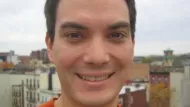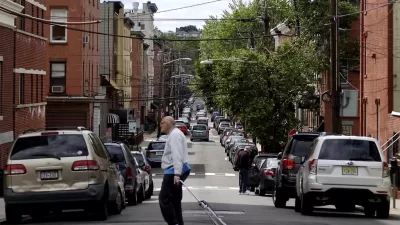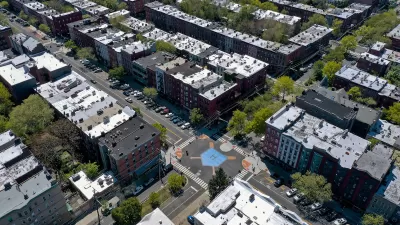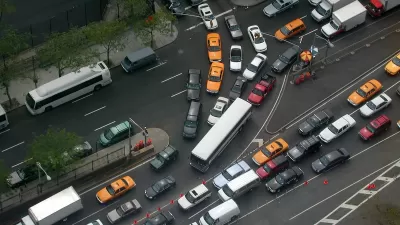Working for a small municipality - regardless of its location - has all the isolating properties of a far-away fiefdom. So it has been with great consternation that, despite being nary a narrow river's width from that island, I have been yet so far removed from the industry-insider privileges of working on transportation projects in Manhattan. I am, admittedly, all but entirely absorbed by work in the New York City satellite of Hoboken, NJ, and while aware of progress as reported by the media, have nonetheless lost granular touch with the revolutionary day-to-day goings-on in my career's former epicenter. From this side of the Hudson I read the broad
Working for a small municipality - regardless of its location - has all the isolating properties of a far-away fiefdom. So it has been with great consternation that, despite being nary a narrow river's width from that island, I have been yet so far removed from the industry-insider privileges of working on transportation projects in Manhattan. I am, admittedly, all but entirely absorbed by work in the New York City satellite of Hoboken, NJ, and while aware of progress as reported by the media, have nonetheless lost granular touch with the revolutionary day-to-day goings-on in my career's former epicenter. From this side of the Hudson I read the broad character essay in the March 4, 2011 edition of the New York Times on New York City Department of Transportation Commissioner Janette Sadik-Khan that summarily says she's made a lot of pivotal transportation changes she believes in and infuriated a lot of people by doing so. If I were still there, perhaps I might have something tangible and lucid to contribute; instead, what I have to offer is merely opinionated, outsider commentary.
All heads are inimitably strong in New York City, and one can imagine that the tussling is never more intense than at the precipitous, jagged peaks of that city's governmental heights. So, invoking of such a rapid philosophical revolution at NYCDOT and blazing to center stage in humanizing the city's most abundant yet inequitably used public space, the city street, coupled with the worldwide attention garnered for doing so, is seemingly more likely the true point of contention than any of Ms. Sadik-Khan's unmeditated reactions or lightening implementations. Yet, the force deemed necessary and enacted to effect such changes is under fire. Some have even capitalized on the emotions associated with these changes to incite when insight is rather what is needed when change is abundant. For certain, change is one of man's greatest fears - and effect always so difficult to ascertain when too near to cause - but the tumultuous emotional aftershocks of Ms. Sadik-Khan's actions in the short term are no certain judgment of her lasting impact on urbanity.
What I will say about the bedazzling transgression from twentieth-century auto-think that has occurred in New York City during Ms. Sadik-Khan's brief tenure there is that it is not to be measured by the stopwatch of ephemeral, political opinions in this time; rather, it is to be weighed on the scholarly scales of pivotal moments in American history. I thank her, with all my transportation engineering-impassioned heart, a thousand times over again for demonstrating and motivating every one of us who strives for delivering to our neighbors an urban life that does not involve constant risk of personal annihilation by rocketing ground-level machines nor an unstoppable usurping of precious public space to the exclusive use of automobiles, that it can be done, and well. Her accomplishments and successes in transforming the American urban transportation landscape are, I believe, very far from being fully realized, and to characterize her impact on our society by the fleeting comments of those embroiled with the immediate demands of high-stakes politics is missing the forest for the trees. Her work, in time, will be seen as the fulcrum about which Americans of all ages and abilities once again regained their right to heedlessly enjoy the streets of their city after a sad, extended episode where cars ruled the right-of-way.
The intense criticism fielded by the seemingly humble (or perhaps humbled) Sadik-Khan, who replied to questions about her goal-focused-at-risk-of-losing-friends manner in the NYT interview by saying ""I can do a better job. I think I've made some mistakes in that arena. We're working on that; I'm certainly working on that.", is mostly characterized in terms of some risk of success with her local, political contemporaries. While certainly fallings out of this sort can bog down progress, if she's not remembered for her political acumen or diplomacy, it in the least begs the question "who cares"?
Janette Sadik-Khan has accomplished more in her time to change the American urban transportation landscape - in perhaps the world's toughest city to do so - since Robert Moses (albeit to opposite effect), and with that change she has empowered millions of politicians, professionals, advocates, and students across the country and beyond to embrace a profound and inspirational confidence obtained by knowing that if the car-king can be conquered in New York City, it can be tamed in every auto-centric urban center of our nation, as well as all those other countries where our lifestyle and popular-cultural trends have a heavy-handed, even if unintended, influence. She has injected a sanity to urban transportation policy that righteously, and rightly, prioritizes human life over driver convenience by introducing a brilliant menu of safety-oriented solutions capable of simultaneously mitigating risk, chipping away at VMT, reducing capital project cost, and shrinking implementation time. We will one day feel honored to have had her focus her dynamism on mounds of lackluster car-focused transportation policy if not her plows on momentary snow piles. Rock on, Janette!
Philosophical Tangent: One official was quoted as saying of her, "She has an absolute certainty that she's correct. I guess it's nice to go through life with that kind of certainty, but I don't know if it's appropriate in government." Admittedly, there are a rare few of us who are blessed in their way to possess such certainty - if that is in fact the state of mind at play here - but I would submit that the last word in that remark would more fittingly be "politics" rather than "government". If properly checked, absolute certainty is an immeasurably useful tool in government. I for one would aspire to achieve absolute certainty in my work, knowing that while I seek the highest and best solution to technical problems, I am yet still subservient to a democratically elected political official with the empathy and contemplative nature that is found in the greatest of all leaders and critical to the business of managing human societies. Perhaps the very reason representative democracies have so far avoided morphing into technocracies is because we instinctively understand that a technocrat, if given ultimate control, may in fact be too unwilling to compromise on the best technical solution to a problem, whereas an elected official must more carefully balance the technical merits of policy with the popular opinion of the constituency and therefore deliver a more compassionate result.

Planetizen Federal Action Tracker
A weekly monitor of how Trump’s orders and actions are impacting planners and planning in America.

San Francisco's School District Spent $105M To Build Affordable Housing for Teachers — And That's Just the Beginning
SFUSD joins a growing list of school districts using their land holdings to address housing affordability challenges faced by their own employees.

The Tiny, Adorable $7,000 Car Turning Japan Onto EVs
The single seat Mibot charges from a regular plug as quickly as an iPad, and is about half the price of an average EV.

Seattle's Plan for Adopting Driverless Cars
Equity, safety, accessibility and affordability are front of mind as the city prepares for robotaxis and other autonomous vehicles.

As Trump Phases Out FEMA, Is It Time to Flee the Floodplains?
With less federal funding available for disaster relief efforts, the need to relocate at-risk communities is more urgent than ever.

With Protected Lanes, 460% More People Commute by Bike
For those needing more ammo, more data proving what we already knew is here.
Urban Design for Planners 1: Software Tools
This six-course series explores essential urban design concepts using open source software and equips planners with the tools they need to participate fully in the urban design process.
Planning for Universal Design
Learn the tools for implementing Universal Design in planning regulations.
Smith Gee Studio
City of Charlotte
City of Camden Redevelopment Agency
City of Astoria
Transportation Research & Education Center (TREC) at Portland State University
US High Speed Rail Association
City of Camden Redevelopment Agency
Municipality of Princeton (NJ)






























